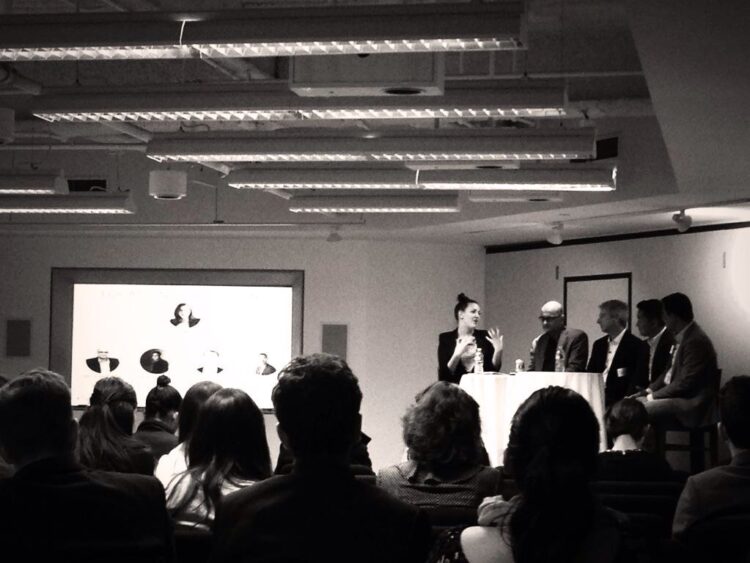Much of today’s attention in the fashion tech world has turned to wearables and IoT. However, if we peel back a layer of this technology progression, we will find that we have yet to crack the mobile code.
Fashion Digital’s FD Mobile event, recently held at Digital Sandbox in the Financial District, explored those questions that are still unanswered. The “Location-Based Selling”panel featured some of the digital experts and founders focused on solving the current problems and creating new standards of commerce. We explore the key trends from their discussion below:
Discovery vs Intent
Nitin Mangtani, CEO, Predict Spring brought to light the consumer behavior patterns that now dictate the purchase process: discovery vs intent. He framed this as ‘search as intent.’
“In the new world, what if we took that query and adopted the call to action to be in line with the physical location?” posited Mangtani. “If you were at home, you would get a very different experience.”
Along these lines, the panel discussed the possibility of identifying specific products vs solely brick and mortar stores. Liza Kindred, Founder of Third Wave Fashion and panel moderator, referenced an article she read about Shazam working on a product that will identify produce in the grocery store. Though discovering a banana through your iPhone seems a bit excessive at the moment, the integration of this technology into everyday life is ripe for disruption.
Said Ethan Song, cofounder, CEO & Creative Director of Frank & Oak, “Whether it’s done through sound or NFC, the physical to digital space is where we are continuously exploring and what we are particularly interested in.”
David Sikora, Chairman of Amberleaf, and founder/former CEO of Digby, spoke about the practicality of applying these technologies. “GPS will fry a battery, while a network location is free and won’t drain the battery. On the other hand, beacons need wifi, but not everyone is always connected. If we’re going to be able to tap into location-based engagement and analytics properly, you have to think about these concepts.”
Making Payments Seamless
“Beacons are passive. NFC is active. Where they meet is the magic.”
Aditya Khurjekar, cofounder of Let’s Talk Payments, added his insights to the panel focused around mobile payment systems.
Khurjekar dove into his learnings about the intersection of radio-frequency identification (RFID) and near field communication (NFC). While RFID technology has enabled the commercial use of beacons to push notifications to mobile devices, Khurjekar was quick to point out that beacons are passive. On the other hand, he highlighted the fact that NFC requires you to take an action by bringing an enabled smartphone either in close proximity to or touching another device in order to activate an action.
“Think about the combination of the two – active plus passive. Now you can do many more things. When we see these things at scale, we will have the answer,” he said.
His experience in Kenya using their M-Pesa payments system was also a strong talking point for Khurjekar. The mobilephone-based money transfer and microfinancing service was a simple process for him to register for, even in the midst of a power outage. His takeaway from this experience was the power of being able to prove someone’s identity seamlessly, with no forms or process times required. Khurjekar believes that this technology will be more widespread in the future, changing the way we interact with payment systems.
Native App First
‘Mobile-first’ has been steadily leading the methodology among marketing professionals and developers, when it comes to building audiences. The discussion touched on the behavior patterns of consumers, and the startups that have succeeded through this approach.
“For millennials, the world starts at the iTunes store, not the browser,” said Nitin.
Brands have taken notice and are incorporating this into their strategies when possible. Sikora’s example was the acquisition of Map My Fitness by Under Armour. By creating native experiences for the consumer, adoption is more successful and a positive process.
Sikora then proposed to the audience of executives and startup attendees, “What are those things can you can fold into your business that change the experience for the customer?”
Customer Experience Above All
The e-retailer Frank & Oak opened several stores in 2013, bringing the physical and digital relationship of their product to the forefront. With the expansion from online to offline, Frank & Oak has been growing and learning what works best for them along the way.
“Finding a way for ecommerce inventory to permeate into the physical store is low-hanging fruit,” said Song. “It always seems a store is out of your size.”
This learning comes from Song’s persistent search for the best customer experience. He positions his strategy along these lines:”How does that actually enhance the customer experience? Does the customer really want self-checkout? Or do we staff the stores for one-on-one experience.”
Understanding their customer and whom they are talking to through a consistent experience is their strength in expansion.
“Our customer is the millennial customer, looking for an authentic connection,” said Song. “They’re already tapping on screens – most of our sales come from mobile and online. Our stores are there to create a community and deliver an experience.”
Song also cited their understanding of how “ownership is irrelevant.”The way people expect to consume products and content is of the streaming mindset.
“Teenagers don’t think about having a hard copy of anything and are not concerned about owning,” said Song. “Commerce is media, media is commerce. Reading an article and buying a product is turning into the same experience. Someone will crack the code for building on top of Instagram and social media. The way that you shop will resemble consuming media.”
Mobile is on its way to coming full circle and integrating seamlessly into the consumer experience. The discussions from FD Mobile highlight the New York fashion tech and e-commerce industry moving the mobile experience forward.




